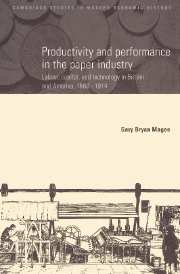 Productivity and Performance in the Paper Industry
Productivity and Performance in the Paper Industry Book contents
- Frontmatter
- Contents
- List of figures
- List of tables
- Acknowledgements
- List of abbreviations
- Introduction
- 1 Background
- 2 Technological change
- 3 Performance
- 4 Rags, esparto, and wood: entrepreneurship and the choice of raw materials
- 5 The Anglo-American labour productivity gap
- 6 Unions and manning practices in Britain and America
- 7 Raw materials, women, and labour-saving machinery: the Anglo-American gap, 1860–1890
- 8 Technological divergence: the Anglo-American gap, 1890–1913
- 9 Free trade and paper
- Conclusion
- Bibliography
- Index
4 - Rags, esparto, and wood: entrepreneurship and the choice of raw materials
Published online by Cambridge University Press: 16 March 2010
- Frontmatter
- Contents
- List of figures
- List of tables
- Acknowledgements
- List of abbreviations
- Introduction
- 1 Background
- 2 Technological change
- 3 Performance
- 4 Rags, esparto, and wood: entrepreneurship and the choice of raw materials
- 5 The Anglo-American labour productivity gap
- 6 Unions and manning practices in Britain and America
- 7 Raw materials, women, and labour-saving machinery: the Anglo-American gap, 1860–1890
- 8 Technological divergence: the Anglo-American gap, 1890–1913
- 9 Free trade and paper
- Conclusion
- Bibliography
- Index
Summary
One of the most important changes to occur in the paper industry in the latter half of the nineteenth century was its shift to a new source of cellulose. In a trade where over half of all running costs were accounted for by raw materials, it was only natural that considerable attention be directed towards assuring that these raw materials remain cheap and available. This was especially so because, by the middle of the nineteenth century, the supply of the industry's traditional raw material, rag, had shown itself increasing unable to meet the expanding needs of the trade. What followed was an intensive search for a new raw material; a search that spanned the world and which captivated the attention of papermakers for many decades.
At an early stage of this search British papermakers began to focus their interest upon a material that seemed to meet all of their requirements. That material was esparto. Between 1860 and the 1880s British paper increasingly came to be made from this grass that grew in the wild in North Africa and southern Spain. It was a choice of raw material that was peculiarly British, as esparto was not to figure to the same extent, if at all, in the industries of other paper-producing nations of the time. In these nations, whilst esparto was ensconcing itself in Britain, wood was steadily establishing itself as the mainstay of the paper trade.
- Type
- Chapter
- Information
- Productivity and Performance in the Paper IndustryLabour, Capital and Technology in Britain and America, 1860–1914, pp. 88 - 144Publisher: Cambridge University PressPrint publication year: 1997


